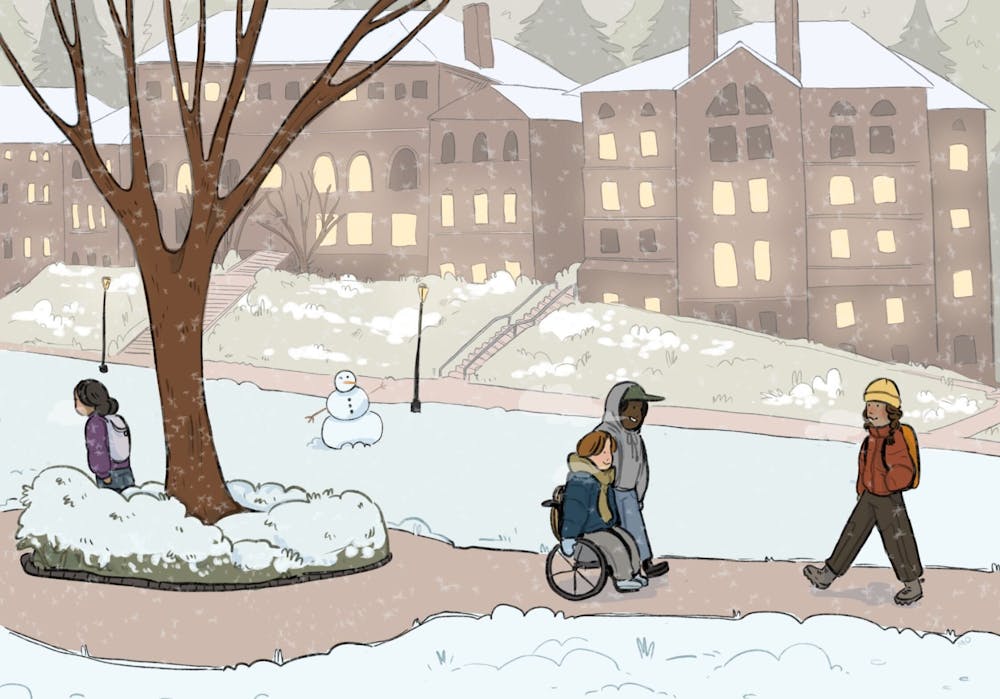For students with disabilities, navigating Western Washington University’s campus on any given day can be difficult. Now that the weather is getting colder, these students must be more careful than ever when getting to class.
According to the National Weather Service, temperatures in Bellingham dropped as low as 8 degrees Fahrenheit. For those with disabilities, the icy sidewalks and snow that come during those winter months present logistical difficulties.
Western third-year Elliott Hawley said the brick walkways can make it difficult to navigate through campus.
“They're hard on your wheels if you're in a wheelchair and they're very easy to trip on if you're a cane user,” Hawley said. “It gets really slippery, and that's dangerous. It's a losing battle with these bricks.”
While Western tries to clear paths that are affected by the weather, some students think they can, and should, be doing more. Seventh-year and student disability advocate Angela Romeo believes staff need to make more effort than what they’re currently doing.
“We get a lot of feedback that it's impossible to clear every path,” said Romero. “But we're not asking for them to clear every path. We're asking for them to be strategic [about] the paths that they do clear.”
When it comes to a solution, Hawley believes the answer is simple: making sure more students with disabilities are included in discussions surrounding campus accessibility.
“I know people here who have every tip and trick in the book to try and solve a problem on their own,” they said. “As a disabled person, they have insights into mobility and orientation that other people don't.”
In an effort to make college campuses more accessible, some schools have decided to work directly with disabled students to decide which routes are a priority.
At the University of Wisconsin-Madison, facilities management works with the McBurney Disability Resource Center, UW Madison’s equivalent to Western’s Disability Access Center, to help decide which routes must be cleared first. Madison saw more than 70 inches of snow in the 2022-23 school year.
“If a student has mobility concerns, they can have their case manager map that route out,” said Top Tantivivat, facilities access specialist at UW Madison. “Every year we coordinate with the grounds and snow removal crews so they know that these are the areas they should pay extra attention to.”
While they recognize Western’s efforts to increase accessibility on campus, Romeo thinks there is still so much needed.
“Western has done things recently to increase access into the middle of campus, which is appreciated,” Romeo said. “But there's still a lot that we're fighting for.”
Despite Western’s efforts to make campus more accessible, some buildings remain inaccessible to those with disabilities. The Ridgeway Commons, the nearest dining hall for students living in the Ridgeway residence halls, is not accessible by wheelchair due to an elevator outage.
This is similar in Western’s humanities building, where a broken elevator limits which students can get to the upper floors of the building.
But until campus becomes more accessible, Western’s DAC is doing its best to pick up the slack. Any student with a disability is eligible for services, with the DAC reporting that 10% of Western students choose to use accommodations every quarter.
While the DAC was unavailable when The Front reached out for comment, information about accessibility accommodations can be found on their website.
The DAC makes sure requesting services isn’t daunting. Students who wish to receive accommodations must submit an application and then meet with a DAC staff member, who will work with the student to determine what services are necessary.
Aidan Hadley (he/him) is a campus life reporter for The Front this quarter. He is a third-year student at WWU studying news/editorial journalism. Outside of reporting, Aidan enjoys baking, eating good food and finding a new TV show to watch. You can reach him at aidanh.thefront@gmail.com.






